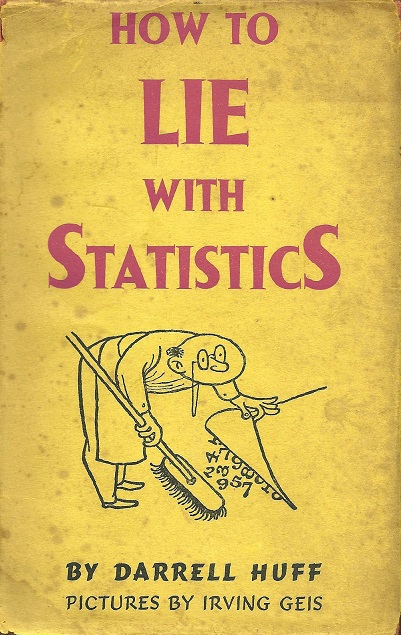posted: May 26, 2018
tl;dr: Teaches the tricks employed by those who attempt to shape opinion by appearing to use factual data...
This is a wonderfully subversive book. Fortunately it has attained the status of classic and is still entirely relevant today in our highly polarized political environment, perhaps even more so than when it was first published in the conformist 1950s (1954 to be exact).
I was given a copy of the book by the most innocent of sources, in my junior year of high school, when my math teacher recommended some extracurricular reading to keep me interested in the subject. I grew up in small town upstate New York, in what is today (and was back then) a reliably red part of the United States. Little did I suspect my math teacher of being a radical at the time, but after I had finished the book I knew his secret.

This book is much more than a math book covering the application and presentation of statistical data. It is actually, in my opinion, one of just two books that together cover all you need to know at a high level to understand politics, which I refer to as “the substitution of beliefs and emotion for fact and reasoning” (yes, I am pretty apolitical). Someday I’ll blog about the second (even older) book, which is also on my all-time ATF list and which explains the fundamental conflict between the two dominant political systems.
How to Lie with Statistics covers the practical side of politics, namely how to selectively use data and how to visualize and present that data to deceive the recipient into reaching the desired conclusions and outcomes. To be fair, these techniques are used in more than just the political arena: you’ll see them used by corporate public relations professionals and inside of companies (especially in board presentations), as well as by individuals. The book itself doesn’t have a particular political point of view: it is just a matter of fact description of the various techniques and how to use them. Politicians of every persuasion use these techniques. If they’ve not all read the book themselves, they have learned these techniques through alternate means.
How to Lie with Statistics presents these techniques in an engaging manner, without heavy mathematics, in what is a fairly short book. Among the techniques covered are selective samples, survey biases, confusing correlation and causation, focusing on changes instead of total quantities, distorting graphs by manipulating the axes and how the data is charted, and failing to present other data which would provide an overall context and a means of comparison. The sins of omission, although less obvious than sins of commission, can actually be more impactful and manipulative.
Thanks to my high school math teacher and How to Lie with Statistics I learned these lessons early in life. Ever since I have read the news and watched campaign speeches and political advertisements with a highly skeptical eye. These techniques are used all the time, by just about everyone in politics and the media. The higher up the politician, the more likely that politician uses these techniques. The statistics quoted by the president (regardless of who it has been in my lifetime) in the State of the Union address are almost entirely produced by following the techniques of How to Lie with Statistics. They can be factually correct, but still present a highly distorted view of reality.
How to Lie with Statistics makes my ATF favorite book list not because it is literary high art, but because of the impact it had on my world view. Read How to Lie with Statistics, learn the techniques others are using to manipulate you, and you too may have a new outlook on the world, especially the world of politics.
Related post: The significance of statistics, and probability